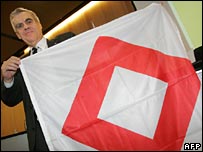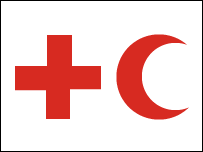|
By Imogen Foulkes
BBC News, Geneva
|


Israel says it is ready to use the new symbol
outside its borders |
In Geneva diplomats from the 192 countries which have signed
the Geneva conventions are meeting to discuss a third emblem for the
international Red Cross.
Red Cross officials hope approval of a third emblem will finally
put an end to decades of controversy over the issue.
At the moment, the only two emblems recognised under the Geneva
conventions are the red cross and the red crescent; relief workers
and ambulances bearing these symbols are protected under
international law.
In war zones or disaster regions, they must be granted free
access to people in need of help.
 |
 We're actually trying to get a solution
for the Red Cross, but some seem to want us to try to solve
the entire Middle East conflict We're actually trying to get a solution
for the Red Cross, but some seem to want us to try to solve
the entire Middle East conflict

|
Over the years, a number of countries have applied to have their
own distinctive emblems recognised, but all have been refused.
Francois Bugnion, director of international law with the
International Committee of the Red Cross (ICRC), believes too many
emblems could compromise protection.
"Hundreds of emblems would mean they would not be recognised, and
so they would not be respected", he explains.
"They would be identified with different countries, so instead of
conveying the message 'this is an ambulance, this is neutral and
must be respected', it would be a sign of identification which would
run against the objective of the protective symbol."
Red Star of David
One country in particular, however, refuses to use either the red
cross or the red crescent.
Israel's Magen David Adom Society (MDA) uses the unrecognised red
star of David as its emblem. As a result, the society is still not a
member of the international Red Cross movement, something which many
Israelis see as unjust.
Israel's ambassador to the UN in Geneva, Itzhak Levanon, shares
that opinion.

At present, only two emblems are officially
recognised |
"MDA is active all over the world," he points out. "In the
tsunami, for example, or following earthquakes, we are often first
on the scene, and we deserve to be part of the international
movement."
The problem is, the star of David is primarily Israel's national
symbol, rather than an emblem of humanitarian relief.
Arab states have made it clear they will never accept the red
star being recognised under the Geneva Conventions.
At the same time, the conventions stipulate that national relief
societies must use only recognised symbols outside their
internationally accepted borders.
That means Israel should probably not be using the red star in
the occupied territories.
Red Crystal
The wrangling over the issue has gone on for decades, and it is
proving costly for the International Red Cross.
For the last five years, the American Red Cross has withheld its
subscriptions to the international movement in protest at Israel's
exclusion, creating a shortfall of over $30m.
The only solution seems to be a third emblem, and Red Cross
officials have come up with a design they hope will please everyone.
To be known as the red crystal, it is a red diamond shape on a
white background.
Israel has said it is ready to use it outside its borders, and,
after some intense negotiations, the MDA and the Palestinian Red
Crescent signed an agreement on working together in the occupied
territories.
Syrian objections
On the surface then, everything looked promising for the approval
of the new emblem.
Switzerland, as the repository state for the Geneva Conventions,
sent out the invitations for the conference, and Swiss diplomats,
who played a key role in getting the agreement between the MDA and
the Palestinian Red Crescent, were initially very optimistic.
But there is one issue which might get in the way - many Arab
countries already see the third emblem as an unnecessary
accommodation of Israel.
Now that the MDA has agreed to work with the Palestinian Red
Crescent in the occupied territories, some are suggesting that a
similar agreement is necessary for the Golan heights.
Since this is also disputed territory, surely, they say, the
Syrian Red Crescent should have a role there?
"The Syrian Red Crescent cannot operate there," insists Mr
Levanon.
"We have no diplomatic relations with Syria, the issue is simply
not in the debate. But I'm not excluding that some Arab countries
will try to raise it, and if they do, the losers will be the
Palestinians," he says.
'Honest endeavours'
In the last few days, Geneva, normally a tranquil city, has seen
a flurry of diplomatic activity, as officials try to reach a
last-minute agreement.
Masood Khan, as ambassador for Pakistan, is negotiating on behalf
of the 56 countries belonging to the Organisation of the Islamic
Conference.
"It's very complicated," Mr Khan says.
"All sides are making honest endeavours to reach agreement. We
must create the right kind of environment where we have an
understanding between the Israeli and Syrian national societies,
because of the question of occupied Golan and whether the Syrian Red
Crescent can operate there."
Frustration
For the Swiss, who have spent months working towards the
conference, and whose foreign minister has made several trips to the
Middle East and Israel in the last few weeks, this last-minute hitch
is causing great anxiety.
"It's frustrating," said one diplomat who asked to remain
anonymous.
"We're actually trying to get a solution for the Red Cross, but
some seem to want us to try to solve the entire Middle East
conflict."
Nevertheless, most diplomats agree that there is, if not
consensus, then at least a majority in favour of the red crystal.
And some do also see the agreement between the MDA and the
Palestinian Red Crescent as a small but hopeful step towards better
relations in the Middle East.
And, if the red crystal is approved, it could have big
implications for the Red Cross movement.
Any country wishing a more neutral emblem will be able to adopt
it and it is thought a number of countries with mixed religious
populations may do so in the long term.
That would mean that the world's best known humanitarian
movement, whose original emblem was simply a reversal of the Swiss
flag, would start to look rather different.